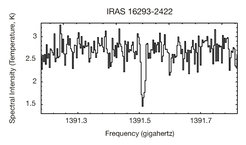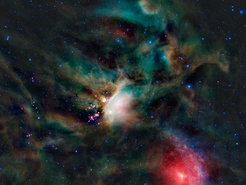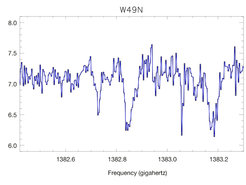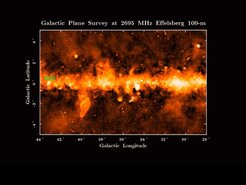New Molecules detected with SOFIA
Observations with the airborne observatory help to understand both sulfur and water chemistry in the interstellar medium
Scientific results from observations made on board NASA's Stratospheric Observatory for Infrared Astronomy, SOFIA, show the first detection in the interstellar medium of two molecules, the mercapto radical SH and the deuterated hydroxyl radical OD. SH is important for the investigation of sulfur chemistry in the interstellar medium, and OD, a version of hydroxyl (OH) with the hydrogen atom replaced by a heavier deuterium atom, plays a corresponding role in understanding the chemical pathways for formation of water in the universe. Both molecules show transition lines in the terahertz regime of the electromagnetic spectrum which cannot be observed from ground-based telescopes.
The detection and investigation of interstellar molecules is one of the strong suits of the German Receiver for Astronomy at Terahertz Frequencies, or GREAT, spectroscopic receiver. The GREAT instrument has been developed by a consortium of German research institutes led by Rolf Guesten of the Max Planck Institute for Radio Astronomy. These results were published during May 2012 in a special issue of the European journal Astronomy & Astrophysics Letters. (GREAT: early science results, A&A 542, F1 (2012), DOI: 10.1051/0004-6361/201219393).

This absorption line spectrum, observed with GREAT on SOFIA, displays the fingerprint of the OD molecule (deuterated hydroxyl radical) at a frequency of 1.3915 Terahertz (215.4 microns wavelength). This molecule is an important marker of the formation of interstellar water and may also serve as a chemical clock for the first stages of the star formation process.
© MPIfR/B. Parise et al., 2012, A&A 542, L5

Infrared image of the rho Ophiuchi star formation region, about 400 light-years from Earth, with dark dusty filamentary gas clouds. The position of the optically obscured low-mass protostar IRAS 16293-2422 towards which the OD molecule has been detected is marked with a red circle.
© NASA/Spitzer/Caltech-JPL/Harvard University/U. Arizona

Two spectral lines of the SH molecule (mercapto radical) are detected in absorption towards W49 around 1383 GHz (217 microns), with lines of other gas constituent along the line of sight and within W49. SH is important for the investigation of sulfur chemistry in the interstellar medium.
© D.A. Neufeld et al., 2012, A&A 542, L6

Radio image of the Milky Way galactic plane. The W49 interstellar cloud complex is the bright radio source at longitude XX, in the direction of the "summer triangle" constellation Aquila. W49 is a region of massive star formation in our galaxy at a distance of approximately 30,000 light years, completely obscured by interstellar dust at visual wavelengths.
© MPIfR/W. Reich



